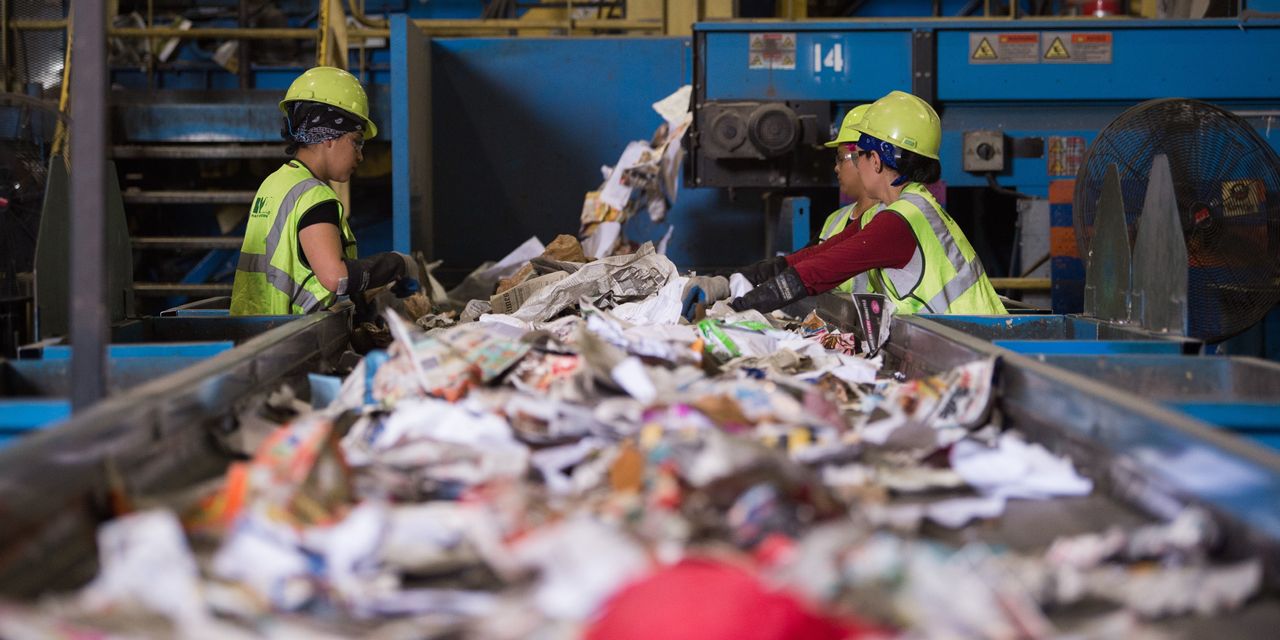A scant 5% of the plastic waste generated in the U.S. last year was recycled, according to new research by Greenpeace.
Americans discarded 51 million tons of wrappers, containers, bottles and shopping bags in 2021. That equates to about 309 pounds of plastic per person per year, of which almost 95% ended up in landfills, in oceans or scattered in the atmosphere. And some, as it breaks down, is injested by people and pets as tiny microplastic particles, Greenpeace said in a report Monday.
Related: Plastic was found in human blood for the first time. Is this a public health risk?
According to the report, which is an update to a 2020 release, mechanical and chemical recycling of plastic waste fails because plastic waste is extremely difficult to collect, virtually impossible to sort for recycling, environmentally harmful to reprocess, often made of and contaminated by toxic materials, and not economical to recycle.
Greenpeace said the problem doesn’t actually lie with households, many of which may believe they are helping reduce the plastic waste issue through recycling efforts. Instead, the activist group says, the problem must be addressed at the plastic production level and via the industries that rely on single-use plastic in particular.
“‘More plastic is being produced, and an even smaller percentage of it is being recycled.’”
Read: Plastic waste is such a big issue, Estée Lauder is looking to space for help
“Single-use plastics are like trillions of pieces of confetti spewed from retail and fast food stores to over 330 million U.S. residents across more than 3 million square miles each year,” said Lisa Ramsden, Greenpeace USA senior plastics campaigner.
“It’s simply not possible to collect the vast quantity of these small pieces of plastic sold to U.S. consumers annually,” Ramsden said. “More plastic is being produced, and an even smaller percentage of it is being recycled. The crisis just gets worse and worse, and, without drastic change, will continue to worsen as the industry plans to triple plastic production by 2050.”
Don’t miss: Recycling is confusing — how to be smarter about all that takeout plastic
We’re getting worse at recycling
The Greenpeace report, Circular Claims Fall Flat Again, updates the 2020 survey of 370 recycling plants which found most plastics were not widely accepted, and even the bottles and jugs were not completely recycled or recyclable.
Not much has changed since the earlier report. In fact the official recycling rate in the U.S. has fallen from a high of 9.5% in 2014 and 8.7% in 2018. At that time, the U.S. like many countries, exported millions of tons of plastic waste to China and, says Greenpeace, counted it as recycled even though much of it was burned or dumped. China stopped accepting plastic waste in 2018.
Not a single type of plastic packaging in the U.S. meets the definition of “recyclable” used by either the Federal Trade Commission or the Ellen MacArthur Foundation’s new plastic economy initiative, the report found.
The MacArthur Foundation funds efforts to change how we design, use and reuse plastics.
“We cannot simply recycle or reduce our way out of the plastic pollution crisis. If we don’t act now, by 2050 there could be more plastic than fish in the oceans,” it says.
Even plastics long considered recyclable — bottles and jugs (PET #1 and HDPE #2) —- fall far short of the 30% recycling rate needed to meet the definition of recyclable by the foundation. The reprocessing rate for the rest of the plastics used by millions of people everyday to wrap leftovers, eat takeout or return unwanted online purchases is less than 5%.
Industry efforts
Widespread users of plastic have launched campaigns aimed at slowing the plastic waste issue.
Coca-Cola Co.
KO,
for one, earlier this year made a commitment to reusing bottles. The announcement prompted several environmental groups to praise the move and at least one activist sustainable investing group declaring the pledge “industry-leading.”
The company said it will sell 25% of beverages in refillables by 2030, up from a current 16%. It may be fitting that the beverage seller made this move; by one measure, a Global Brand audit, Coke is the world’s largest plastic polluter.
And, consumer goods giant Unilever
ULVR,
has committed to halving the new plastic for its goods by 2025 — a goal that would cut its use to 386,000 tons of new plastic each year from around 772,000 tons in 2018.
To hit this mark, the Anglo-Dutch seller of Dove soap, Ben & Jerry’s ice cream and Lipton tea will offer more reusable and refillable packaging, and sell more “naked,” or unwrapped, products. The company will also use more recycled plastic in its packaging and will invest in waste collection and processing, it announced in 2019.
Greenpeace said with this week’s report that broader industry should support an ambitious Global Plastics Treaty that will finally end the age of plastic. The treaty is currently being drawn up after more than 170 nations in March backed a historic U.N. resolution to end plastic pollution. Draft versions call for an international legally binding agreement to be in place by 2024. It’s hoped by proponents that the treaty will determine the trajectory of the plastic pollution crisis for generations to come, with packaging being replaced with reuse and refill systems or no packaging at all.
Conversely, if the status quo continues, global plastic use and waste will nearly triple by 2060 with only a small increase in plastic recycling, according to a recent report by the Organization for Economic Cooperation and Development (OECD).
Read: Here’s the tiny percentage of plastic that’s recycled despite single-use bans, taxes and incentives



